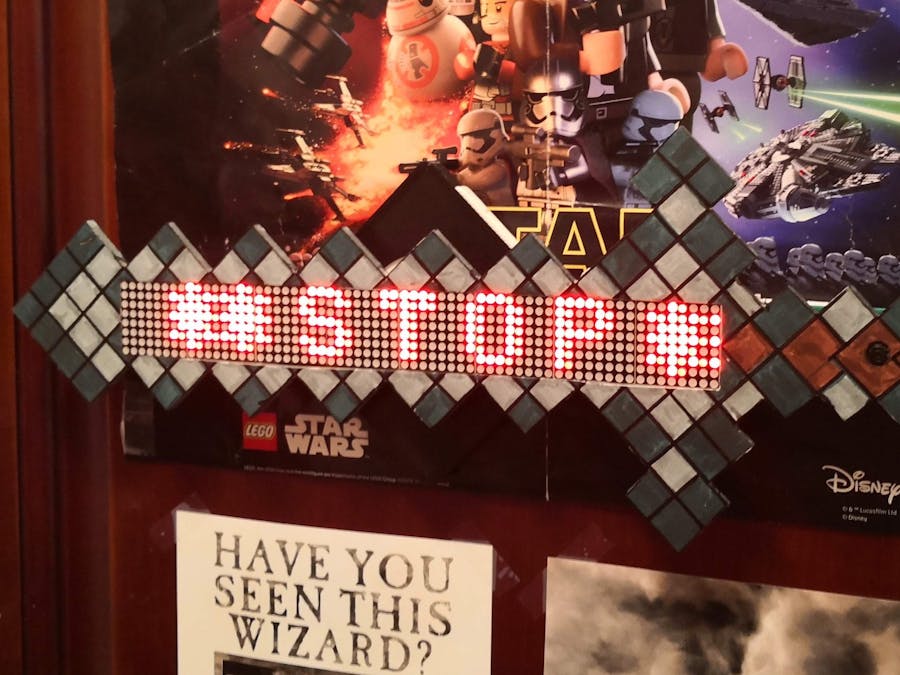There are really several reasons why this project came into existence:
1. As an author of cooperative multitasking library TaskScheduler I was always curious how to combine the benefits of cooperative multitasking with the benefits of pre-emptive one. There are benefits to both and both have shortcomings. Combining the two allows a unique opportunity to leverage benefits and play down issues of either based on a particular use-case. Interesting? Read on...
2. The very fact that ESP32 is a multi-core microcontroller is fascinating. I was always curious if I can take advantage of that feature. So the experiment here was: can ESP32 stream video smoothly using one core while doing something else (meaningful and reasonably intensive something else) on the other core. Even more interesting?? Read on...!
3. I needed a testing ground for my recent projects around OTA firmware provisioning and configuration management...
4. I had purchased two LED Dot Matrix modules some time ago and could not figure out what to do with them...
5. My son is a Minecraft gamer, and as any small boy loves to decorate his door with "Do not enter" posters...
So here you go - all good reasons for:
Interactive Do Not Enter door sign with ESP32-CAM streaming of a video feed "from behind the closed door" - or "Who is coming to my room?"
So... what is it all about?If you have patience to read the whole story you realize that this is not really about a Minecraft sword. This project is a proof of a lot of concepts:
- Coexistence of Preemptive and Cooperative multitasking
- Selective use of ESP32 cores
- Use of new Dictionary and EspBootstrap libraries
- OTA firmware provisioning
- Configuration management
- Video streaming to multiple clients
- and a lot more.
Enjoy!
Final ProductI'll start with how the final product looks like, and then explain how it was built and how to control it. It seems more engaging this way...
And, of course, a video:
Sword FaceplateThe sword faceplate is made from the whiteboard, marked with a pencil, and colored with Crayola markers. This alone could be an interesting project with your kid:
- Mark up a sword on a whiteboard
- Cut out the faceplate
- Mark up the squares (or blocks)
- Color them individually
- Add black lines with a sharpie
I included an open office document with a sample picture of a diamond sword that you can glue on top of the whiteboard if you prefer shortcuts...
Once everything is done you can either hot-glue the faceplate to the rest of the assembly or use double-sided tape.
Dot Matrix LED displayI had 2 of them, 4 segments each, so I decided to make one 8-segment one.
Conveniently there is a 5-pin male header on one side, and matching 5 holes on the opposite side. Bending the male header into a staple-like ] shape, I was able to connect the two modules both electrically and mechanically! Killed two birds with one stone (or two flies with one swat, to stop two mouths with one morsel, to make two friends with one gift, to have two strings to one bow, what are other idioms to that matter - have you thought? Sorry, I digressed).
The opposite male header will be used to connect a matching female header from the veroboard with ESP32-Cam and other components.
The two components are connected with a 3d-printed bridge, which also houses a switch to turn the power on and off.
3d STL files for bridge and other components are located in the files/3d folder on GitHub.
The Sword is powered by a 2500 mAh USB power bank - the smallest and thinnest I could find. Powerbank slides into a 3d-printed case, which also attaches to the dot matrix modules, thus holding the entire thing together.
There are two round magnets glued to the power bank case, and that is how the sword is attached to the door (so it could be as easily detached for maintenance).
The real schematic is located on GitHub, but a picture is worth 1000 words (1024 in Information Technology), so here you are:
This is fairly straightforward if you know your way with a soldering gun.
NOTE: The 3d bridge part is designed for a very specific veroboard size: 30 x 70 mm. Should you decide to use a different one, you need to re-design the bridge component.
The battery case and a bridge connecting ESP32-CAM veroboard to the dot-matrix display assembly were 3d designed and printed.
The battery case comes in 2 parts, that need to be glued together after printing to create a "pocket" for the battery.
The bridge just needs to be cleaned of all the support structures (there is no good orientation really that minimizes them, unfortunately).
STL files are on GitHub and TinkerCad originals are located here.
The 3D design on TinkerCad also includes the simulated assembly schematic of how the parts fit together and should be connected.
... and now: the interesting stuff:
ProgrammingMulti-multitasking
This design uses FreeRTOS for preemptive multitasking and TaskScheduler library for cooperative one. Sword's behavior and messages are controlled via Blynk App.
After setup (pins, camera and dot-matrix initialization, connecting to WiFi, etc.), two main RTOS tasks are created:
- Video streaming RTOS task, pinned to the Application Core of ESP32 (core 1)
- Text display and Blynk control RTOS task, pinned to the Power Core of ESP32 (core 0), which also is responsible for all WiFi-related tasks. Text and Blynk related execution is managed via TaskScheduler tasks.
I found out that 4K of stack space is enough for RTOS tasks, but there is a possibility of running out of stack, so if you prefer, make it 8K - there is plenty of RAM on ESP32.
All video capturing and streaming happens on Core 1. Everything else - on Core 0.
ESP32 has enough power to handle all of that with breaking a little sweat (the board does get hot when streaming video).
THIS was the main goal of the project: peaceful and productive coexistence of preemptive and cooperative multitasking!
Dot Matrix ControlI am using very powerful MD_Parola and MD_MAX72xx libraries also available in Arduino IDE library manager.
All textual special effects are done via those libraries. It took a little bit of effort to determine the correct MAX72XX hardware type (MD_MAX72XX::ICSTATION_HW in my case, yours may be different), after that, controlling text is a breeze.
The sword allows the following controls:
- Brightness
- Blinking
- Flash
- Scroll speed and direction (up/down, left/right, steady)
- You can also turn it into a Wall Clock
Blynk App has a little widget to video streaming, but you can stream into the browser, VLC player, or anything that supports MJPEG standard.
Up to 10 connected clients are supported.
You will have to find out the IP address of your ESP32-CAM to be able to connect to it. You can look it up on your router, or compile this sketch with _DEBUG_ option enabled first, and read the IP address of the terminal when it connects to your network.
IMPORTANT: It is very advisable to assign a permanent IP address to, or create a DHCP reservation for, the ESP32-CAM module so its address does not change when the lease expires. You can also modify the Blynk App to update the IP address in the stream URL - an interesting homework assignment if you are up to it.
The current sketch uses a QVGA resolution: 320x240 pixels, which makes it quite fast. You are free to and encouraged to play with other resolutions and decide what works for you.
RAM should not be a problem as the sketch does take advantage of the PSRAM.
ConfigurationThe sketch takes advantage of my Dictionary and EspBootstrap libraries to load configuration parameters from the configuration server upon boot.
I run my own configuration server, which you can do as well (it is a simple Apache2 web server really just serving JSON files).
You can also use any of the online services available for the task: (OTADrive, Microsoft Azure, AWS IoT, etc.). In this case please do change the String makeConfig(String path) method to appropriately construct a URL pointing to your configuration source. Alternatively, you can save the configuration file into the SPIFFS filesystem on ESP32-CAM and read it from there, or just hardcode all the entries. Please see README of the EspBootstrap library for your options.
An example of a configuration file is provided on GitHub.
If you prefer to hardcode parameters, an example is below:
pd("Title", "DND Sword Setup");
pd("ssid", "your wifi ssid");
pd("password", "your wifi password");
pd("msg", "Hello!");
pd("devices", "8");
pd("blynk_auth", "your blynk AUTH UUID");
// if you run your own server only:
pd("blynk_host", "your blynk server IP");
pd("blynk_port", "your server port");The sketch also is OTA (Over The Air) firmware update enabled and is checking for new firmware at every boot.
Again, I run my own OTA update server, which you can do as well (it is a simple Apache2 webserver with a little bit of PHP scripting serving binary files).
You can also use any of the online IoT services available for the task: (OTADrive,Microsoft Azure,AWS IoT, etc.). In this case please do change the void checkOTA() method to appropriately construct an update URL pointing to your binary file source.
This is optional - you might choose to just upload binaries via serial connection.
MJPEG ServerThis is already described here. No need to repeat.
Blynk AppBlynk is a cloud-based IoT platform that allows rapid App development. It is free for personal use and even has the option of running your own Blynk server.
I (as you might have already guessed) am running my own Blynk server, but it might be easier for you to use the cloud version.
Install the Blynk iOS or Android App, and follow the pictures below to reconstruct the App on your phone.
You will need to provide your own Blynk Auth UUID for the application to work with your App. This is why I use configuration files. However, for a one-off project, a hardcoded value would work just as fine.
IMPORTANT: Please make sure your Blynk Project is set to Notify Devices When App Connected.
NOTE on the video streaming widget: sometimes the video does not start. It does not seem to be a problem with ESP32, rather with the video widget of the Blynk application. Try closing and reopening the App or stopping/starting the project again. Eventually, it does start. This problem does not seem to exist in the browser or VLC player (for instance).
Enjoy!It was a lot of fun building this and proving that a postmark-sized device like ESP32 can do a lot more than just stream video. A lot of concepts from this project could be re-used in other applications.
Please leave a comment or contact me directly if you have questions and/or ideas!











Comments